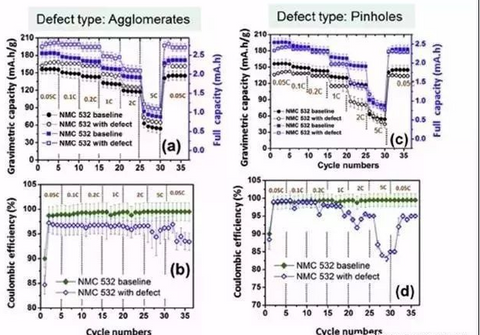
Akumulatory CNHL Lipo
CNHL dąży do dostarczania wysokiej jakości baterii Li-Po oraz produktów RC wszystkim entuzjastom hobby, oferując doskonałą obsługę klienta i konkurencyjne ceny
Rysunek 1 przedstawia typowy defekt na powierzchni bieguna baterii litowo-polimerowej 4s, po lewej obraz optyczny, po prawej obraz zarejestrowany przez kamerę termowizyjną.

Rys. 1 Typowe defekty na powierzchni bieguna: (a, b) Wypukłe worki/agregaty; (c, d) Ubytki/otwory; (e, f) Metalowe ciała obce; (g, h) Nierówne pokrycie
(a, b) Wypukłe bele/agregaty, takie defekty mogą wystąpić, jeśli zawiesina jest mieszana nierównomiernie lub szybkość nanoszenia powłoki jest niestabilna. Agregacja spoiwa i przewodzącego węgla sadzy skutkuje niską zawartością składnika aktywnego i lekkimi biegunami.
(c, d) Ubytki/otwory, te defektowe obszary nie są pokryte powłoką i zwykle powstają w wyniku pęcherzyków powietrza w zawiesinie. Zmniejszają ilość aktywnego materiału i odsłaniają kolektor prądu na elektrolit, co obniża pojemność elektrochemiczną.
(e, f) Metalowe ciała obce, metalowe ciała obce wprowadzone do zawiesiny lub sprzętu i środowiska, metalowe ciała obce są bardzo szkodliwe dla baterii litowo-polimerowej 4s. Większe cząstki metalu bezpośrednio przebijają separator, powodując zwarcie między elektrodą dodatnią a ujemną, co jest zwarciem fizycznym. Ponadto, gdy metalowe ciała obce są wymieszane z elektrodą dodatnią, potencjał elektrody dodatniej wzrasta po naładowaniu, metal rozpuszcza się, dyfunduje przez elektrolit, a następnie osadza się na powierzchni elektrody ujemnej, ostatecznie przebijając przegrodę i tworząc zwarcie, co jest zwarciem chemicznym. Najczęściej spotykanymi metalowymi ciałami obcymi na terenie fabryki baterii 4s lipo są Fe, Cu, Zn, Al, Sn, SUS itp.
(g, h) Nierównomierne powlekanie, takie jak niewystarczające wymieszanie zawiesiny, powoduje pojawienie się smug, gdy ziarnistość cząstek jest duża, co skutkuje nierównomiernym powlekaniem, co wpłynie na spójność pojemności baterii 4s lipo, a nawet może wyglądać jak brak powlekania. Smugi mają wpływ zarówno na pojemność, jak i bezpieczeństwo.
Termowizja w podczerwieni (IR) jest używana do wykrywania drobnych defektów na suchych elementach biegunowych, które mogłyby uszkodzić wydajność baterii litowo-jonowych 4s lipo. Podczas inspekcji online, jeśli wykryte zostaną defekty elektrod lub zanieczyszczenia, oznacza się je na elementach biegunowych, usuwa w kolejnych procesach i przekazuje z powrotem do linii produkcyjnej, aby na czas dostosować proces i wyeliminować defekty. Podczerwień to fala elektromagnetyczna o tej samej naturze co fale radiowe i światło widzialne. Użycie specjalnego urządzenia elektronicznego do przekształcenia rozkładu temperatury powierzchni obiektu w obraz widoczny dla ludzkiego oka oraz wyświetlenie rozkładu temperatury powierzchni obiektu w różnych kolorach nazywa się technologią termowizji w podczerwieni, a to urządzenie elektroniczne nazywa się termowizorem podczerwieni. Wszystkie obiekty powyżej zera absolutnego (-273°C) emitują promieniowanie podczerwone.
Jak pokazano na Rysunku 2, termowizor na podczerwień (kamera IR) wykorzystuje detektor podczerwieni oraz optyczny obiektyw obrazujący do odbioru rozkładu energii promieniowania podczerwonego mierzonego obiektu i odzwierciedla go na elemencie światłoczułym detektora podczerwieni, aby uzyskać obraz termiczny w podczerwieni. Ten obraz termiczny odpowiada polu rozkładu termicznego na powierzchni obiektu. Gdy na powierzchni obiektu występują defekty, w tym obszarze pojawia się przesunięcie temperatury. Dlatego ta technologia może być również używana do wykrywania defektów na powierzchni obiektu, zwłaszcza tych, których nie można rozpoznać metodami optycznymi. Podczas testowania na linii suchego elementu biegunowego baterii litowo-jonowej 4s lipo, najpierw element biegunowy jest naświetlany lampą błyskową, co powoduje zmianę temperatury powierzchni, a następnie temperatura powierzchni jest wykrywana przez termowizor. Obraz rozkładu termicznego jest wizualizowany, a obraz jest przetwarzany i analizowany w czasie rzeczywistym, a defekty powierzchni są wykrywane i oznaczane na bieżąco. Badania D. Mohanty'ego zainstalowały termowizor przy wylocie suszarki powlekacza, aby wykrywać obraz rozkładu temperatury na powierzchni elementu biegunowego.
Rysunek 2. Schemat wyglądu powierzchni bieguna wykrytej termowizją

Rysunek 3(a) przedstawia rozkład temperatury na powierzchni powłoki elektrody katodowej NMC wykryty termowizją, zawierający bardzo mały defekt niewidoczny gołym okiem. Krzywa rozkładu temperatury odpowiadająca odcinkowi linii jest pokazana na wstawce, gdzie w punkcie defektu występuje skok temperatury.
W polu odpowiadającym obrazowi na rys. 3(b) temperatura lokalnie wzrasta, co odpowiada defektowi na powierzchni bieguna.
Rysunek 4 to wykres rozkładu temperatury powierzchni bieguna ujemnego pokazujący istnienie defektów, gdzie szczyty z podwyższoną temperaturą odpowiadają pęcherzykom lub aglomeratom, a obszary z obniżoną temperaturą odpowiadają dziurkom lub ubytkom.


Rysunek 3 Termowizyjny rozkład temperatury na powierzchni elektrody dodatniej
Rysunek 4 Termowizyjny rozkład temperatury na powierzchni bieguna ujemnego
Można zauważyć, że termowizyjna detekcja rozkładu temperatury jest dobrą metodą wykrywania defektów powierzchni biegunów i może być stosowana do kontroli jakości produkcji biegunów.
Rysunek 5 przedstawia krzywą wpływu aglomeratów i dziurek na zdolność prądową i sprawność kulombową baterii 4s lipo. Aglomeraty faktycznie mogą zwiększyć pojemność baterii 4s lipo, ale obniżają sprawność kulombową. Dziurki zmniejszają pojemność i sprawność kulombową baterii 4s lipo, a sprawność kulombowa znacznie spada przy wysokich prądach.

Rys.5 Wpływ pozytywnych aglomeratów i dziurek na zdolność prądową i sprawność kulombową baterii 4s lipo
Rys.6 to krzywa wpływu niejednorodnej powłoki oraz metalicznych zanieczyszczeń Co i Al na pojemność przy dużych prądach i efektywność kulombową baterii 4s lipo. Niejednorodna powłoka zmniejsza jednostkową pojemność masową baterii 4s lipo o 10%-20%, ale pojemność całej baterii 4s lipo spadła o 60%, co pokazuje, że jakość żywych elementów w elemencie biegunowym została znacznie obniżona. Metaliczne zanieczyszczenia Co zmniejszają pojemność i efektywność kulombową, a nawet przy wysokich prądach 2C i 5C pojemność jest zerowa, co może wynikać z tworzenia stopów przez metal Co w reakcji elektrochemicznej, co utrudnia odlitowanie i interkalację litu, lub może być spowodowane zatkaniem porów separatora przez metaliczne cząstki, powodując mikrozwarcia.
Rys.6 Wpływ niejednorodnej powłoki katody oraz metalicznych zanieczyszczeń Co i Al na pojemność przy dużych prądach i efektywność kulombową baterii 4s lipo
Podsumowanie defektów dodatniego elementu biegunowego: Aglomeraty w powłoce dodatniego elementu biegunowego obniżają efektywność kulombową baterii 4s lipo. Dziurki w powłoce katody obniżają efektywność kulombową, co skutkuje słabą wydajnością przy dużych prądach, zwłaszcza przy wysokich gęstościach prądu. Niejednorodne powłoki wykazują słabą wydajność przy dużych prądach. Zanieczyszczenia metaliczne mogą powodować mikrozwarcia, co znacznie obniża pojemność baterii 4s lipo.

Aglomeracja: przy 2C współczynnik utrzymania pojemności baterii 4s lipo z elementem biegunowym bez defektu wynosi 70% po 200 cyklach, a baterii z defektem 12%. Przy 5C współczynnik utrzymania pojemności baterii 4s lipo z elementem biegunowym bez defektu wynosi 50% po 200 cyklach, a baterii z defektem 14%.
Dziurka: Spadek pojemności jest wyraźny, ale nie tak szybki jak w przypadku defektu aglomeratu. Współczynnik utrzymania pojemności przy 2C i 5C po 200 cyklach wynosi odpowiednio 47% i 40%.
Obcy metalowy przedmiot: Pojemność baterii z obcym metalowym przedmiotem jest prawie zerowa po kilku cyklach, a pojemność folii aluminiowej z obcym metalem przy cyklu 5C znacznie spada.
Przeciekające paski folii: Przy tej samej powierzchni przeciekającej folii, w porównaniu z dużym paskiem (współczynnik utrzymania pojemności 47% po 200 cyklach przy cyklu 5C), pojemność baterii 4s lipo z wieloma małymi paskami spada szybciej (współczynnik utrzymania pojemności po 200 cyklach przy cyklu 5C wynosi 7%). Pokazuje to, że im większa liczba pasków, tym większy wpływ na cykl życia baterii 4s lipo.
Cóż, powyższe to pełna treść dotycząca rodzajów defektów elementów biegunowych baterii 4s lipo, ich wpływu oraz metod wykrywania, które CNHL przedstawiło dziś. Wierzę, że po przeczytaniu całego tekstu, zrozumienie elementów biegunowych baterii 4s lipo przez wszystkich pogłębiło się. Więcej informacji o bateriach litowych jest stale aktualizowanych, do zobaczenia w następnym wydaniu.

CNHL dąży do dostarczania wysokiej jakości baterii Li-Po oraz produktów RC wszystkim entuzjastom hobby, oferując doskonałą obsługę klienta i konkurencyjne ceny
Specyfikacje: Numer magazynowy: 500706EC5 Pojemność: 5000mAh Napięcie: 22.2V / 6-Cell / 6S1P Prąd rozładowania: 70C ciągły / 140C impulsowy Prąd ...
Zobacz pełne szczegółySpecyfikacje: Numer magazynowy: 1351506PZ Pojemność: 1350mAh Napięcie: 22.2V / 6-Cell / 6S1P Szybkość rozładowania: 150C ciągłe / 300C chwilowe M...
Zobacz pełne szczegółySpecyfikacje Numer magazynowy: 1301306BK Pojemność: 1300mAh Napięcie: 22.2V / 6-Cell / 6S1P Prąd rozładowania: 130C ciągły / 260C impulsowy Prąd ł...
Zobacz pełne szczegółySpecyfikacje: Numer magazynowy: 1501204 Pojemność: 1500mAh Napięcie: 14.8V / 4-Cell / 4S1P Szybkość rozładowania: 120C ciągłe / 240C impulsowe Mak...
Zobacz pełne szczegółySpecyfikacje: Numer magazynowy: 220303BK Pojemność: 2200mAh Napięcie: 11.1V / 3- ogniwa / 3S1P Wskaźnik rozładowania: 30C ciągły / 60C impulsowy M...
Zobacz pełne szczegółyVOLANTEX BF109 4-kanałowy samolot RC RTF przenosi jeden z najbardziej ikonicznych myśliwców II wojny światowej do kompaktowego, przyjaznego dla ...
Zobacz pełne szczegółyVolantex RC Plane P51D V2 RTF to kompaktowy warbird w stylu II wojny światowej, zaprojektowany tak, aby nauka latania była jak najbardziej relak...
Zobacz pełne szczegółyMF-A84 690mm bezszczotkowy samolot RC to model w stylu wojskowym inspirowany klasycznymi myśliwcami takimi jak P-47 Thunderbolt i Ki-84. Z potęż...
Zobacz pełne szczegółySpecyfikacje: Numer magazynowy: 6001006EC5 Pojemność: 6000mAh Napięcie: 22.2V / 6-Cell / 6S1P Prąd rozładowania: 100C ciągły / 200C impulsowy Prą...
Zobacz pełne szczegółySpecyfikacje: Stock Number: 6001004 Pojemność: 6000mAh Napięcie: 14.8V / 4-Cell / 4S1P Szybkość rozładowania: 100C ciągłe / 200C chwilowe Maksyma...
Zobacz pełne szczegóły
Zostaw komentarz